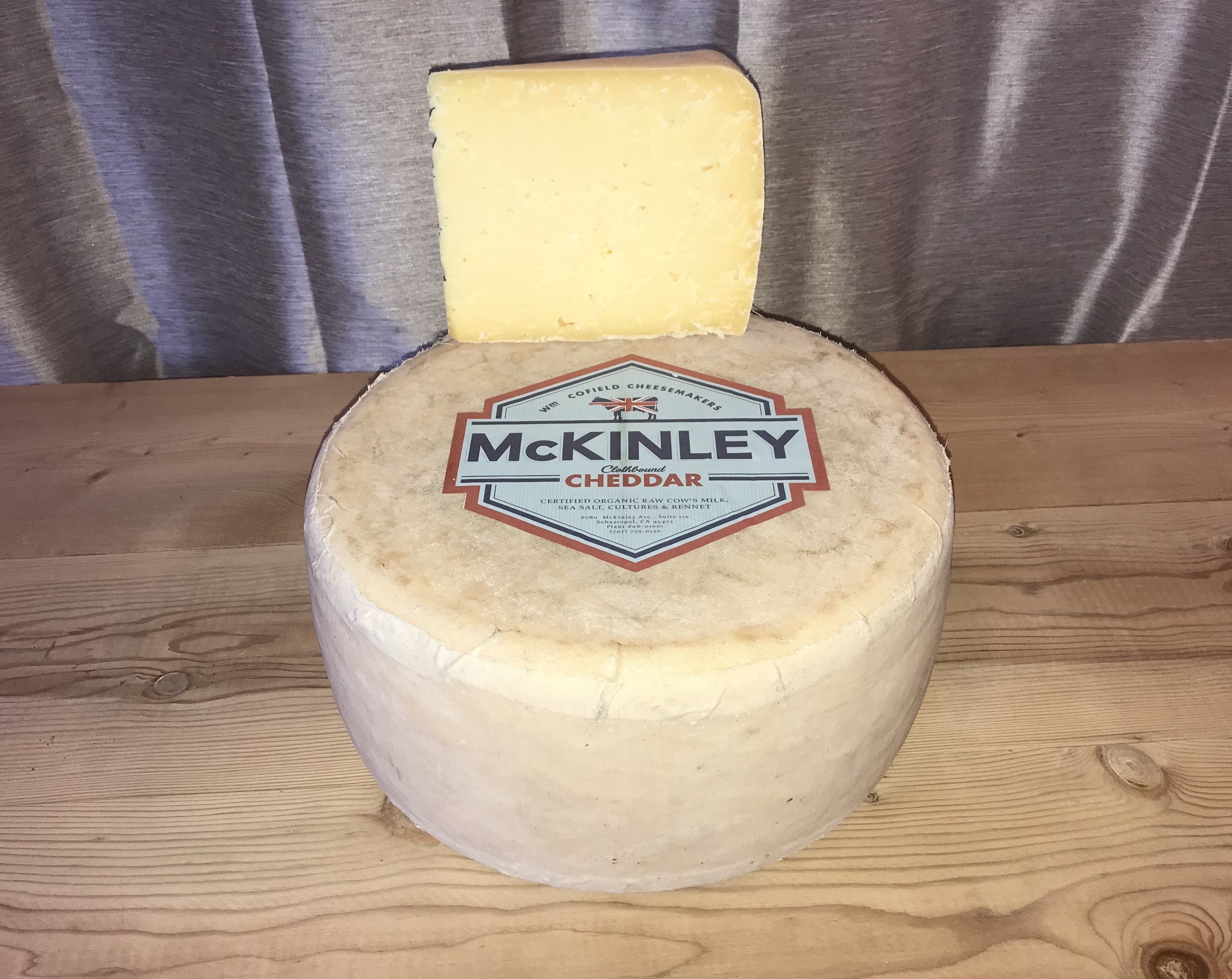"When the idea of British style cheese entered my head and we looked around and realized that there wasn't anyone focusing on that, it seemed a natural fit.” Keith Adams
William Cofield enters the Sonoma cheese market with two British style hard cheeses: An aged Cheddar and a Stilton-inspired blue.
Having mastered a Camembert-style soft cheese with his Alemar Cheese Company, in Minnesota, Keith Adams was eager for not only a new product, but a location closer to his native California. As a child and later a 17-year-old, he'd lived in England for several years and over time developed a taste for and interest in British-made cheese. Once he became an artisan cheesemaker, he looked closer at the cheesemaking by celebrated names in English cheese and liked what he saw: sustainable, pasture-focused dairies and work environments that were equal parts laid-back and passionately on task in producing traditional British cheese.
To learn the real deal, Keith reached out to cheesemakers in both the U.S. and Great Britain. His reputation opened doors all the way to rural England, where he was invited to observe and work in two operations he considered Ground Zero of traditional, sustainable British cheese: The Stichelton Dairy about 150 miles north of London and the Westcombe Dairy in Somerset County in Southwestern England.
STILTON-ESQUE
William Cofield models its Stilton style cheese close to the Stichelton Dairy's namesake product. This cheese uses raw, sustainable milk instead of pasteurized milk. It would otherwise be labeled Stilton, but British law says that to use the Stilton name, the milk used must be pasteurized, the process of which sacrifices flavor-enhancing microbes.
At the Stichelton Dairy, Keith worked with and observed the cheesemakers whose process is top-to-bottom traditional, with little to no automation involved. Even the vats of curds and whey were hand-stirred.
“Making a raw milk cheese requires attention, expertise, and finesse," Keith says. “But man, if you get it right it’s beautiful.”
When the cheese is formed into molds, they are put into a warm, moist room called a hastener for several days. After that, they're stored in a cool, humid aging room. Ordinarily hard cheeses get pressed, but no pressure is applied to Stichelton to expel the whey. They're simply turned over daily and left to drain via gravity over the course of several days.
After a number of weeks, the cheese is pierced with stainless steel needles; the process allows air to activate the blue mold that permeates the cheese, sweetening its path throughout.
The final product: Bodega Blue.
The result, as Keith noted, is a cheese of rich and satisfying complexity.
“We’re drawing direct inspiration from the technique and practices of England, and combining it with the terroir, the milk and the feel of the Sonoma coast."
AGED CHEDDAR
Cheddar is a verb. And at Westcombe Dairy, Keith cheddared.
"To cheddar is to stack knitted curds on top of each other to expel whey. You cut it, you stack it, and you wait," he said. "This process is repeated as many as eight times."
Before the cheddaring, however, the mixing of curds is a vigorous process, as is the essential salting “to get into all the nooks and crannies.” The cheese is put into a press overnight where the whey is expelled to create a cheese best suited to long-term aging.
The following day, the Cheddar is taken out of the press, coated and wrapped in muslin cloth, protecting the rind but still allowing the cheese to breathe.
The Cheddar is aged for up to one year and turned regularly in the aging room.
Wm. Cofield proudly presents: McKinley Cheddar.
The lessons learned at Westcombe and Stichelton are at the core of what takes place at William Cofield's production plant at The Barlow.
THE CURDS
Yes, cheese curds. The playful snack has come to Sonoma, created with the same care and detail used in the aged cheddar and Stilton-inspired blue. Unlike those, however, William Cofield's cheese curds use pasteurized milk, a requirement as it can be eaten the same day it's produced.
Making fresh, delicious curds available at The Barlow location is bound to add a festive flair to the neighborhood - a little hint of Sonoma County meets Minnesota State Fair.
“In a way its a nod to my midwestern cheesemaking roots," Keith said, "and it’s also a way of saying we take cheese very seriously, but we’re also having a lot of fun.”
THE COWS
The Camozzi family, whose Willow Creek Jerseys supplies the milk to Wm. Cofield.
The curds, just as the two hard cheeses, are made with organic milk from grass-fed animals at Willow Creek Jerseys, one of several dairy operations led by the Camozzi family.
Robert Camozzi’s family has been dairying in the Two Rock Valley outside of Petaluma for nearly a century. Robert’s great grandfather, John D’Ambrogi, was among the founding dairy farmers of the Petaluma Cooperative Creamery in 1913.
After taking their Triple C Ranch dairy operation organic in 2001, Robert and family started the jersey dairy Willow Creek Jerseys in 2010. Both Triple C Ranch and Willow Creek Jerseys pasture their cows every day during grazing season. Robert and his wife Norene oversee a large family – the next in line to run the operation.
“Sustainability isn’t profitability, though that’s important,” Robert says. “It’s seeing the business from generation to generation.”
William Cofield is proud and fortunate to use this family’s Willow Creek milk as the foundation for our cheese. It fits beautifully with one of Keith's central tenets of cheesemaking: "The best milk makes the best cheese."





